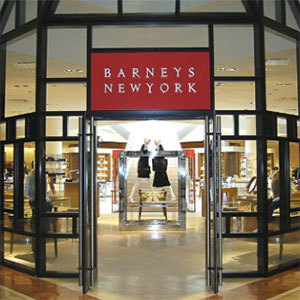
Barneys New York is reportedly exploring bailout options to help alleviate the pressures of its expensive leases, which insiders say are draining the luxury department store chain’s finances.
Barneys, which is a fundamentally old-world department store that specializes in off-the-runways fashion, is known for selling apparel—but it’s also one of the most globally influential retailers of fine fashion jewelry. The company operates 28 locations, including Barneys Warehouse outlets. Several of its flagships are located in areas that rank among the most expensive zip codes in the world, including Madison Avenue in New York and Wilshire Boulevard in Beverly Hills, Calif.
Business of Fashion reported last week that the retailer is exploring options that include a bankruptcy filing, “as it struggles with high rents and changing consumer tastes.” The retailer is working with law firm Kirkland & Ellis LLP “to prepare for a potential bankruptcy” that could come in the next few weeks, according to the article.
Reportedly, it’s not a done deal yet. The retailer may ultimately go a different route to ease its financial burdens.
And Barneys has been through bankruptcy before, for the purpose of reorganizing for a sale. The company was sold to United Arab Emirates–based private equity firm Istithmar World for $937.4 million in 2007. The company could be readying for another sale now. A liquidation—the other option for businesses in bankruptcy—doesn’t seem likely. But then it was once hard to imagine a world without Toys R Us, and here we are.
Maintaining costly leases in the age of online shopping is becoming increasingly less tenable. But overhead is only part of Barney’s viability problem. In an article this week, Refinery 29 writer Channing Hargrove astutely noted that the retailer “has failed to adapt to the changing landscape of retail, racially-profiling black customers [the retailer settled in a racial-profiling case in 2014], and carrying limited sizes despite 67% of women in the U.S. wearing a size 14 or larger.”
For decades, Barneys has been the benchmark for high-fashion retail in the United States for both designers and consumers. Over the years, I’ve personally spoken to several fine jewelry designers who considered getting their collections into Barneys their “made it” moment.
But consumer attitudes are changing rapidly. Young designers, brands, and retailers have made transparency and inclusivity (size, gender, and race) not only the norm, but also legitimately cool. Where does that leave Barneys New York, a retailer that rose to prominence and success by trading in the ultra-exclusive? We may soon find out.
(Photo courtesy of Barneys New York)
- Subscribe to the JCK News Daily
- Subscribe to the JCK Special Report
- Follow JCK on Instagram: @jckmagazine
- Follow JCK on X: @jckmagazine
- Follow JCK on Facebook: @jckmagazine